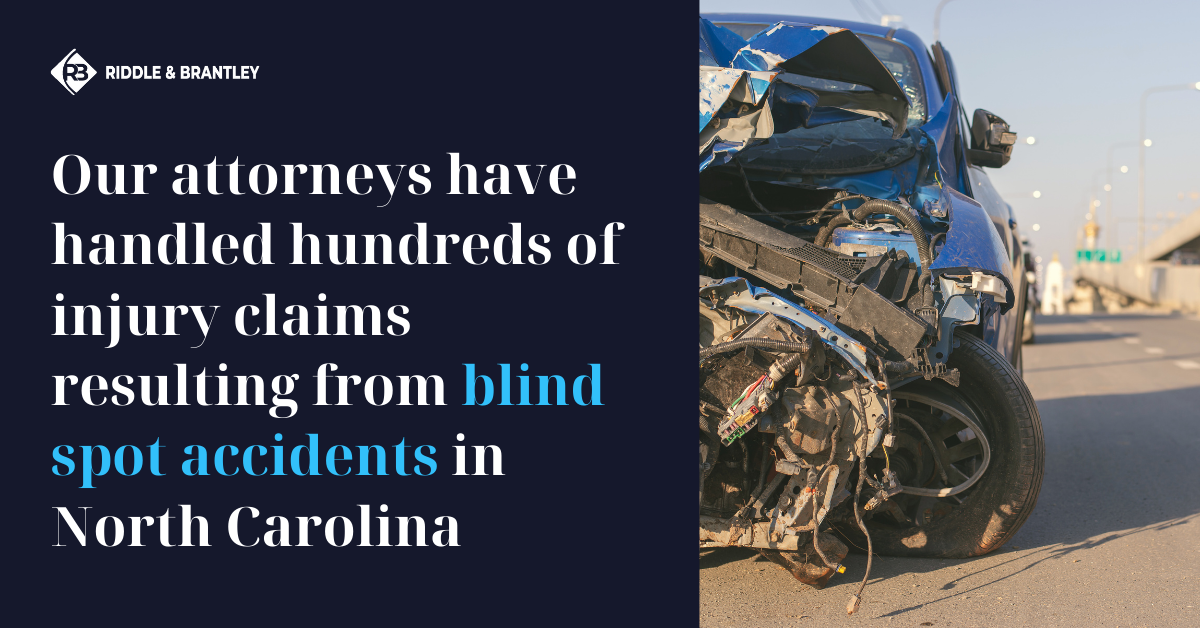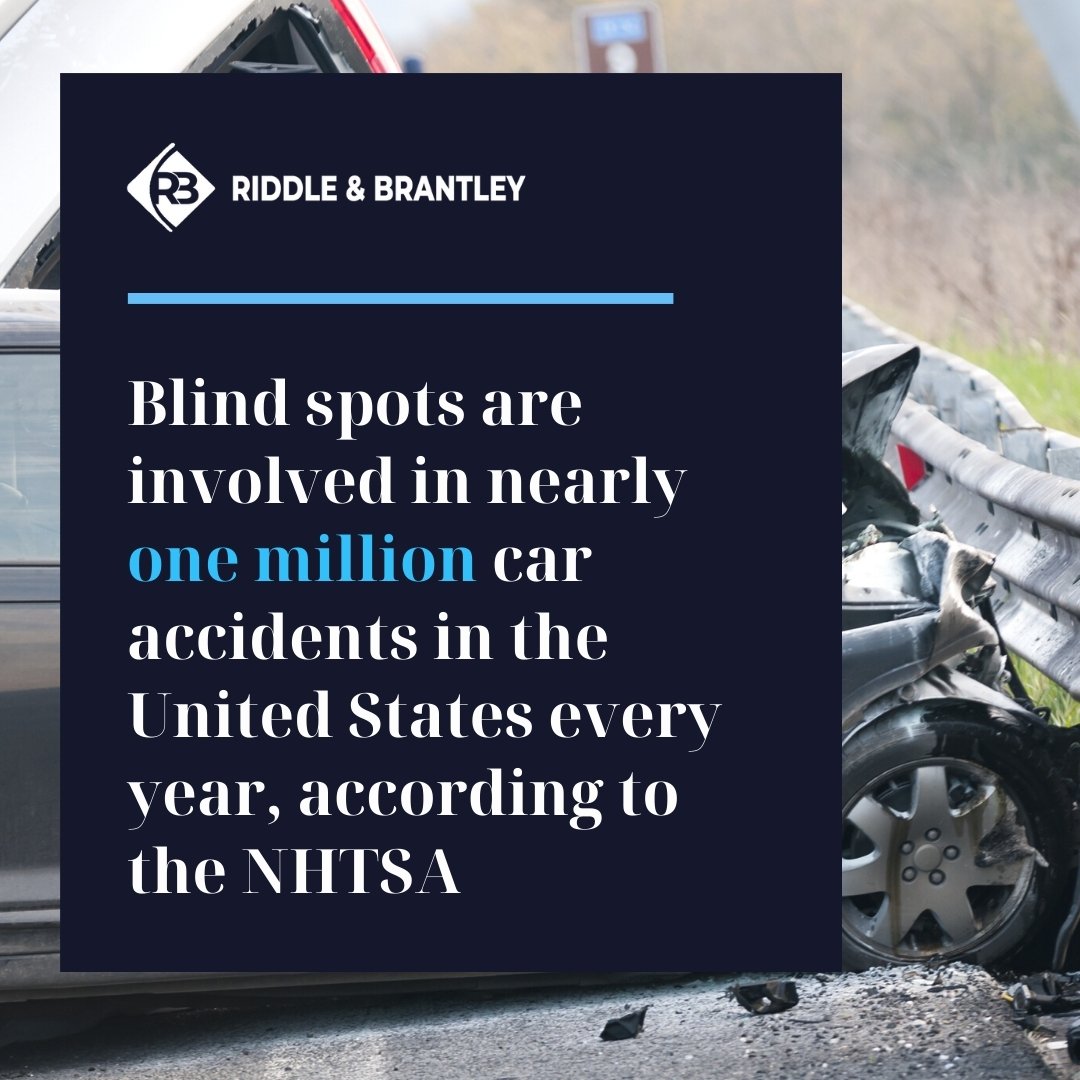Blind Spot Car Accident Lawyers in North Carolina
 Blind Spot Motor Vehicle Law in North Carolina
Blind Spot Motor Vehicle Law in North Carolina
In North Carolina, according to G. S. 20-126 (b) and (c), all motor vehicles, including motorcycles, are required to have at least one outside or rear view (in the case of motorcycles) mirror so that they can see vehicles approaching on the sides and rear. The external mirror on cars and trucks needs to be on the driver’s side according to the statute.
Blind Spot Accident Lawyer
An experienced blind spot accident lawyer can help protect your legal right and get you the compensation you deserve.
Vehicle blind spots cause hundreds of thousands of accidents every year. Even with advanced technology, all vehicles still have blind spots. If a driver is not alert and conscientious, blind spots can lead to deadly car accidents.
Fault in Blind Spots Accidents
Often, drivers who cause car accidents claim that they never saw the other vehicle. If you were hit by another driver and your vehicle was in the driver’s blind spot, this may be true. However, failure to see another vehicle is not an excuse for causing a car crash and does not absolve the at-fault driver from liability.
At Riddle & Brantley, our North Carolina blind spot accident lawyers have experience standing up to insurance companies who may try to blame you, the victim, for blind spot accidents.
If you or a loved one has been injured in a car accident that was not your fault, you deserve compensation for your losses and damages – even if the other driver claims a blind spot is to blame.
Compensation or “damages” may include medical expenses, lost wages, loss of future income, and property damages, among others.
For a FREE consultation with an experienced North Carolina blind spot accident lawyer, please call 1-800-525-7111.
There is no obligation, and you won’t pay any attorney fees unless we win your case and you receive compensation.
Call 1-800-525-7111 today and let’s talk.
“Riddle & Brantley found me all the available money from the insurance companies.”
–David H., Riddle & Brantley client
What Are Blind Spots?
Blind spots are the areas surrounding a vehicle which the driver of the vehicle cannot see. Even with rear-view and side mirrors, drivers cannot see all angles surrounding their vehicle. ALL vehicles have blind spots, and for some large vehicles like trucks and busses, these blind spots can pose a real danger to unsuspecting passing vehicles.
Blind spots are known to cause many car accidents across our North Carolina roadways and throughout the United States.
Blind Spot Statistics

The National Highway Traffic Safety Adminstration (NHTSA), a primary source of U.S. traffic accident statistics, has found that blind spots are responsible for causing nearly 840,000 accidents every year in the United States. Recent data released by the NHTSA show that blind spot accidents are responsible for approximately 300 fatalities a year.
Where Are Blind Spots Located?
In most cases, blind spots are located over the right and left shoulder of the driver. However, they can also be caused by the “pillars” connecting the roof to the body of the vehicle. In addition, passengers or objects in the vehicle can obscure a driver’s vision as well. Blind spots surrounding your vehicle can also shift as your line of vision changes while driving. Additionally, as other vehicles move into the lane zones surrounding your vehicle, a car you saw in your review mirror a few seconds ago can easily move into your blind spot just a few seconds later.
Safe driving habits include taking blind spots into account when turning, merging or backing up. However, negligent or complacent drivers may fail or forget to check blind spots, leading to often avoidable accidents. Victims of blind spot accidents can suffer a range of serious personal injuries, and at worst, wrongful death.
Common injuries resulting from blind spot accidents include:
- Back injuries
- Neck injuries (including whiplash)
- Internal organ damage
- Spinal cord injury
- Shoulder injuries
- Traumatic brain injury (TBI)
- Head injuries (including concussions)
- And many more…
Blind Spot Car Accidents
The most common type of blind spot accidents occurs when a driver tries to change lanes but does not notice another vehicle traveling beside and partially behind the driver’s line of sight. When the driver attempts to move into the adjacent lane, the driver collides with the other vehicle or forces it off the road. Depending on the speed of the vehicles and force of impact, these collisions can be violent. Blind spot accidents can still happen even when a driver glances in his mirrors to check for another vehicle before changing lanes.
However, blind spots are not limited to those directly surrounding the vehicle. Blind spots can be greatly influenced by factors in your outside surrounding as well, such as other vehicles, trees, or other large objects. Failing to monitor blind spots can be particularly dangerous in certain driving situations:
- Truck Blind Spots: Due to their sheer size, large trucks have notoriously poor blind spot visibility. Even with large side view mirrors, truck drivers have extremely limited vision along the sides of their trailers and directly behind. Therefore, truck drivers often cannot see vehicles traveling directly beside or behind them. Blind spots are a leading cause of large truck accidents and often result in very serious injuries for victims in passenger vehicles.
- Turning Into Oncoming Traffic: Blind spots aren’t just limited to the area within a driver’s hard-to-see angles. Particularly when traffic is heavy, attempting to make a left turn across two lanes of oncoming traffic can create a dangerous situation when other vehicles block a driver’s view of oncoming traffic in the outer lane. Even if a friendly driver waves you through an opening in traffic, you could still be found at fault for this type of blind spot accident.
- Lane-Changing: Poor awareness of blind spots is especially hazardous when changing lanes. Statistics compiled by the NHTSA show that 18 percent of vehicle collisions in the U.S. occur during lane changes. Failing to notice a vehicle in the driver’s blind spot is one of the most common causes of lane change collisions.
- Crosswalks & Intersections: Blind spots can also occur at intersections, especially those with crosswalks where pedestrians are common. Objects in your surroundings can greatly limit your visibility, and these blind spots may frequently shift as your vehicle’s line of vision changes with your car’s forward movement.
- Reversing or Backing Up: Rear blind spots can be incredibly dangerous to drivers. Depending on the type of vehicle, a driver can have severely limited rearview vision. This is especially true of larger vehicles, trucks, or ones with a narrow rear window. The NHTSA estimates that rear blind spots cause nearly 18,000 injuries every year in the U.S. Modern rear-view camera technology can greatly reduce the risk of this type of blind spot accident.
Other additional types of blind spots accidents include:
- Car vs. bicycle
- Car vs. motorcycle
- Rear-end collisions
- Rollover accident
- Car vs. pedestrian
- Car vs. truck
- Sideswipes
As with any car accident claim, the severity of the crash depends on the speed and location of the impact. However, since blind spot collisions typically happen at full speed, the resulting car accident injuries are often severe.
How to Prevent Blind Spot Accidents
Although it is impossible to prevent every accident, there are several easy steps a driver can take to reduce blind spots on their vehicle and lower the risk of blind spot accidents.
Most importantly, by practicing defensive driving habits and obeying all traffic laws, individuals may be able to prevent accidents from occurring. In addition to safe driving habits, other steps drivers can take to avoid blind spot accidents include:
- Adjusting Side Mirrors– Properly adjusting your side mirrors is critical to minimizing blind spots along the sides of your vehicle. You can do this by leaning as far to the right as possible, then adjusting your right mirror so you can barely see the body of your vehicle. Next, lean to the left side of your vehicle and adjust that mirror so it is barely visible as well. This will widen your field of vision and give you a greater range of visibility.
- Blind Spot Mirrors– You can place blind spot mirrors on the side mirrors in order to allow for an increased visibility, which may eliminate blind spots. Most auto part stores across the state of North Carolina carry these types of mirrors. These small mirrors mount easily to the outer corners of the side mirrors.
- Convex Mirrors– You can replace your normal mirrors with convex mirrors in order to increase the driver’s visibility. The face of a convex mirror curves slightly outward, thus providing a wider angle of visibility. These mirrors are common on tractor-trailers and other large trucks.
- Reducing Speed– Excessive speed is a major cause of injuries and deaths in North Carolina traffic accidents. NC Department of Transportation (NC DOT) statistics show that speeding is a contributing factor in approximately 22 percent of all fatal crashes in our state. Of these fatal wrecks, 88 percent of NC speed-related fatalities occurred on roads with posted speed limits of 55 mph or less. These statistics show that most speed-related accidents occur not on interstates, but on secondary roads. By reducing speed and driving within the speed limit, drivers are able to better respond to sudden hazards and avoid car accidents that may result from a blind spot.
Contact Our North Carolina Car Accident Lawyers Today
 If you or a loved one has been injured or killed in a car accident in North Carolina, Riddle & Brantley’s North Carolina car accident attorneys believe that Justice Counts and we are ready to help however we can.
If you or a loved one has been injured or killed in a car accident in North Carolina, Riddle & Brantley’s North Carolina car accident attorneys believe that Justice Counts and we are ready to help however we can.
Blind spot accident victims may be entitled to compensation for their losses and damages, including medical expenses, lost wages or earning potential, loss of companionship, and pain and suffering.
For a FREE consultation with an experienced North Carolina car accident lawyer handling blind spot accident claims (including blind spot truck accident claims), please call 1-800-525-7111.
The consultation is free and we don’t get paid unless you do. If we don’t recover compensation for you, you won’t pay any attorney fees.
“They made a hard time in my life easier to endure.”
–Melissa C., Riddle & Brantley client
Our personal injury attorneys have been serving injured victims across the state of North Carolina for more than 35 years and are prepared to seek fair compensation benefits for your losses and damages today. We’ve recovered millions of dollars in compensation (see disclaimer below) and would love to help you.
Call 1-800-525-7111 today and let’s review your claim.
Justice Counts.
*** Disclaimer: The results mentioned are intended to illustrate the type of cases handled by the firm. These results do not guarantee a similar outcome, and they should not be construed to constitute a promise or guarantee of a particular result in any particular case. Every case is different, and the outcome of any case depends upon a variety of factors unique to that case.